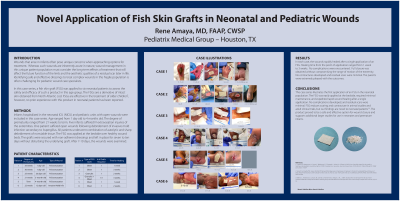Case Series/Study
(CS-007) Novel Application of Fish Skin Grafts in Five Neonatal Wounds

Wounds that arise in neonatal infants often pose unique concerns when approaching options for treatment. Whereas such wounds are inherently acute in nature, wound management in this unique patient population must consider the long-term effects of treatment that will affect the future function of the limb and the aesthetic qualities of a residual scar later in life. Identifying safe and effective dressings to treat complex wounds in this fragile population is often challenging for pediatric wound care specialists. In this case series, a fish skin graft (FSG) was applied to five neonatal patients to assess the safety and efficacy of such a product in this age group. The FSGs are a derivative of intact skin obtained from North Atlantic cod. FSGs are effective in the treatment of older children1, however, no prior experience with this product in neonatal patients has been reported.
Methods:
Neonatal (< 30 days of life) and extreme premature (< 28 weeks gestation) patients with open wounds were included in this case series. One patient suffered open wounds following the debridement of infected tissue secondary to Aspergillus. Four other neonatal patients suffered IV extravasation injuries of the extremities. The FSG was applied at the bedside over healthy wound beds after successful debridement of nonviable tissue. The grafts were secured with non-adherent dressings and left in place for seven to ten days without disturbing the underlying graft. After one week, the wounds were examined.
Results:
In each case, the wounds rapidly healed after a single application of an FSG. No complications were encountered. Full closure was obtained without compromising the range of motion of the extremity. No contractures developed and residual scars were minimal. The parents were extremely pleased with the outcomes.
Discussion:
This case series illustrates the first application of an FSG in the neonatal/premature population. The FSG was easily applied at the bedside, required minimal maintenance, and expedited rapid wound healing after a single application. No complications developed, and residual scars were minimal. FSG reduces scaring and contracture in animal studies and adult clinical trials, but our findings are novel to neonatal patients2,3. The product proved to be a safe and effective option for wound closure and supports additional larger studies for use in neonates and premature infants.
Trademarked Items: Kerecis® MariGen Micro
Kerecis® MariGen
References: 1. Ciprandi, G., Kjartansson, H., Grussu, F., Baldursson, B. T., Frattaroli, J., Urbani, U., & Zama, M. (2022). Use of acellular intact fish skin grafts in treating acute paediatric wounds during the COVID-19 pandemic: a case series. Journal of wound care, 31(10), 824–831. https://doi.org/10.12968/jowc.2022.31.10.824
2. Stone R 2nd, Saathoff EC, Larson DA, Wall JT, Wienandt NA, Magnusson S, Kjartansson H, Natesan S, Christy RJ. Accelerated Wound Closure of Deep Partial Thickness Burns with Acellular Fish Skin Graft. Int J Mol Sci. 2021 Feb 4;22(4):1590. doi: 10.3390/ijms22041590. PMID: 33557424; PMCID: PMC7915828.
3. Wallner, C., Holtermann, J., Drysch, M., Schmidt, S., Reinkemeier, F., Wagner, J. M., ... & Behr, B. (2022). The Use of Intact Fish Skin as a Novel Treatment Method for Deep Dermal Burns Following Enzymatic Debridement: A Retrospective Case-Control Study. European Burn Journal, 3(1), 43-55.

.png)